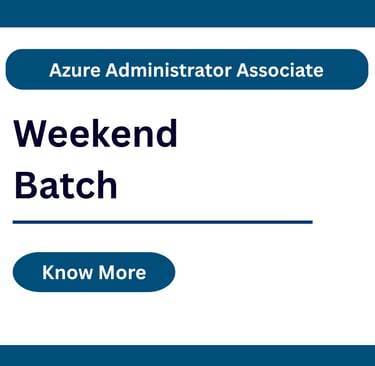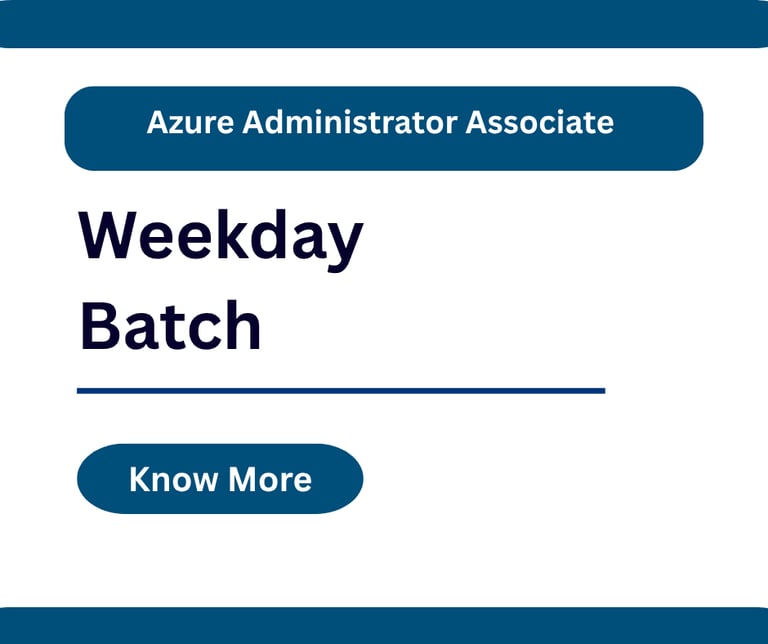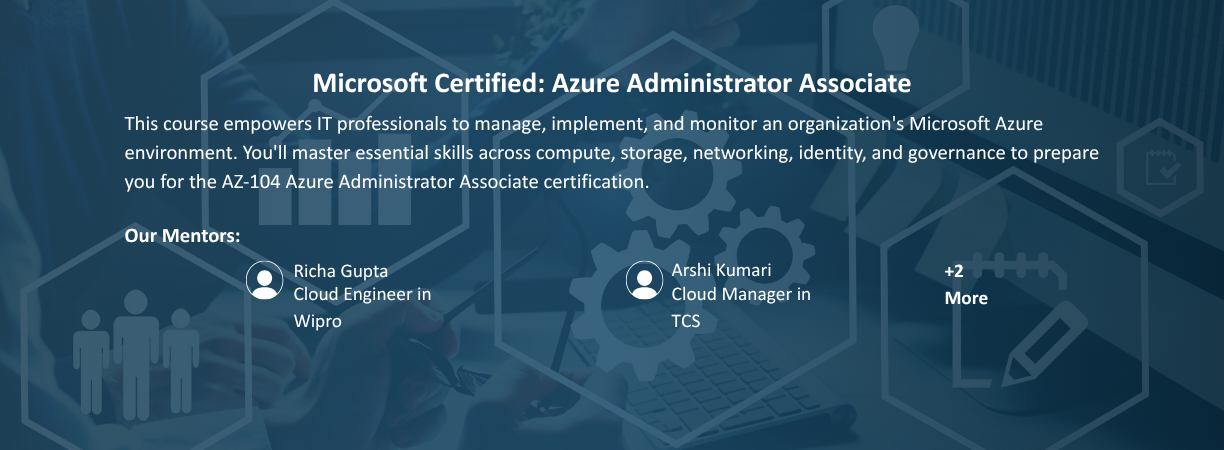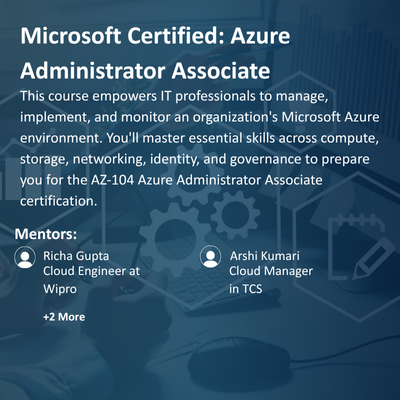







Major Industry Recruiters








Major Industry Recruiters
Course Description:
This course is designed for IT professionals who want to gain expertise in managing, implementing, and monitoring an organization's Microsoft Azure environment. The curriculum covers the essential services across the core pillars of an Azure deployment: compute, storage, networking, identity, and governance.
Learners will develop the practical skills required to provision, size, monitor, and adjust resources in the Azure cloud, using tools like the Azure Portal, Azure PowerShell, the Azure Command-Line Interface (CLI), and ARM/Bicep templates. Upon completion, you will be prepared to take the Exam AZ-104: Microsoft Azure Administrator and earn the official certification.
Course Objective:
Upon successful completion of this training, participants will be able to:
1. Identity, Governance, and Access Control
Manage Microsoft Entra ID (formerly Azure Active Directory), including the creation and administration of users, groups, licenses, and implementing Multi-Factor Authentication (MFA).
Implement and enforce organizational standards by configuring Azure Policy, resource locks, and management groups.
Apply Role-Based Access Control (RBAC) principles to assign built-in roles and create custom roles for fine-grained access management.
2. Storage Implementation and Management
Configure and secure various Azure Storage Account types, manage redundancy options (LRS, GRS, ZRS), and control access using Shared Access Signatures (SAS) and network firewalls.
Implement and manage Azure Files (File Sync) and Azure Blob Storage, including configuring life-cycle policies and storage tiers for cost optimization.
3. Compute Resource Deployment and Automation
Deploy, size, and configure Azure Virtual Machines (VMs), managing disks and ensuring high availability using Availability Zones and Availability Sets.
Automate the deployment of Azure resources using declarative templates like Azure Resource Manager (ARM) or Bicep files.
Provision and scale containerized solutions by managing Azure Container Registry and Container Instances, and configure App Service plans.
4. Virtual Networking and Secure Connectivity
Configure and secure Azure Virtual Networks (VNets), subnets, and VNet peering, and implement traffic filtering using Network Security Groups (NSGs) and Application Security Groups (ASGs).
Establish secure intersite and remote connectivity using VPN Gateways (Site-to-Site and Point-to-Site) and manage traffic distribution via Azure Load Balancer and Application Gateway.
5. Monitoring, Backup, and Disaster Recovery
Monitor Azure resources effectively using Azure Monitor to interpret metrics and logs, and configure sophisticated alert rules and action groups.
Implement and maintain comprehensive data protection by configuring Azure Recovery Services vaults, backup policies for VMs/file shares, and performing restore operations.
Configure and manage Azure Site Recovery to establish disaster recovery for critical Azure workloads to a secondary region (including failover and failback procedures).
Course Module:
The course is structured around the five core domains of the AZ-104 exam, with a heavy emphasis on hands-on practical skills.
1. Manage Azure Identities and Governance
Manage Microsoft Entra ID: Create and manage users, groups, and licenses; configure Multi-Factor Authentication (MFA) and self-service password reset (SSPR).
Manage Access Control (RBAC): Understand and assign built-in roles; interpret access assignments and create custom roles.
Manage Subscriptions and Governance: Implement and manage Azure Policy to enforce standards; configure resource locks, tags, management groups, and manage billing costs.
2. Implement and Manage Storage
Configure Storage Accounts: Create and configure various types of storage accounts, including redundancy options (LRS, GRS, ZRS).
Configure Access to Storage: Manage Shared Access Signatures (SAS) tokens and access keys; configure Azure Storage firewalls and network access.
Configure Azure Files and Blob Storage: Manage blob life-cycle policies, configure storage tiers, and implement Azure File Sync for file shares.
3. Deploy and Manage Azure Compute Resources
Deploy and Configure Virtual Machines (VMs): Create, size, and deploy VMs; configure Azure Disk Encryption, manage VM disks, and implement High Availability using Availability Zones and Availability Sets.
Automate Deployment: Deploy resources using Azure Resource Manager (ARM) templates or Bicep files.
Manage Containers and App Services: Create and manage Azure Container Registry and Container Instances; provision and scale Azure App Service plans and deployment slots.
4. Configure and Manage Virtual Networking
Configure Virtual Networks: Create and configure Virtual Networks (VNets), subnets, and VNet peering.
Implement Secure Access: Create and configure Network Security Groups (NSGs) and Application Security Groups (ASGs); implement Azure Bastion for secure connectivity.
Configure Intersite Connectivity: Configure VPN Gateways (Site-to-Site and Point-to-Site) and understand ExpressRoute concepts.
Configure Load Balancing: Implement Azure Load Balancer and Application Gateway for traffic distribution.
5. Monitor and Maintain Azure Resources
Monitor Resources with Azure Monitor: Configure and interpret metrics and logs; set up alert rules and action groups.
Implement Backup and Recovery: Configure Azure Recovery Services vaults; create and manage backup policies for VMs and file shares; perform backup and restore operations.
Implement Azure Site Recovery: Configure disaster recovery for Azure resources to a secondary region (failover and failback).
Course Overview:

Upcoming Batches: Choose as per Your Requirement




Our Mentors:
Richa Gupta
Cloud Engineer in Wipro
Arshi Kumari
Cloud Manager in TCS
Ahmed Khan
Cloud Engineer in Cognizant
Abhishek Singh
Cloud Engineer in IBM
Our Mentors:
Richa Gupta
Cloud Engineer in Wipro
Aina Rathor
DevOps Engineerex-Deloitte
Ahmed Khan
Coud Engineer in Cognizant
Coud Engineer in IBM
Abhishek Singh
Our Alumni Work at Top Companies
FAQs – Azure Administrator Associate at GIMIT
Here are 10 Frequently Asked Questions (FAQs) for the Microsoft Certified: Azure Administrator Associate (AZ-104) course, based on the provided content:
Who should take this Azure Administrator Associate course?
This course is designed for IT professionals, Network Engineers, and administrators who want to gain expertise in managing, implementing, and monitoring an organization's Microsoft Azure cloud environment.
What prerequisites are recommended for this training?
A foundational knowledge of cloud concepts, basic networking, and general Azure services (equivalent to the AZ-900 level) is highly recommended for success.
How long is the duration of this training program?
The training is structured over 20 days, with sessions lasting approximately two hours per day.
Which official Microsoft exam does this course prepare me for?
This course directly prepares you to take and pass Exam AZ-104: Microsoft Azure Administrator, which leads to the official Microsoft Certified: Azure Administrator Associate certification.
What is the core objective of the AZ-104 certification?
The objective is to validate your subject matter expertise in implementing, managing, and monitoring an organization's cloud environment, including core services like storage, compute, and networking.
What are the five core skill domains covered in the curriculum?
The course is structured around the five key areas validated by the AZ-104 exam: Identity & Access, Storage, Compute, Virtual Networking, and Monitoring & Maintenance.
What kind of hands-on tools will I learn to use?
You will develop practical administration skills using the Azure Portal, Azure PowerShell, the Azure Command-Line Interface (CLI), and learn to automate resource deployment using ARM or Bicep templates.
Does the course cover Azure security and identity management?
Yes, a key domain is dedicated to managing Microsoft Entra ID (user/group management, MFA) and implementing access control using Role-Based Access Control (RBAC) and Azure Policy.
Will I learn about disaster recovery in Azure?
Absolutely. The course includes modules on implementing Backup and Recovery via Azure Recovery Services vaults, as well as configuring and managing Azure Site Recovery for disaster recovery.
What topics are covered in the virtual networking section?
You will learn to configure Virtual Networks (VNets), Network Security Groups (NSGs), secure intersite connectivity via VPN Gateways and ExpressRoute, and traffic distribution using Load Balancers and Application Gateway.





